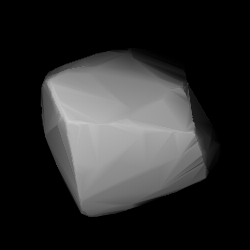Related Research Articles

214 Aschera is a Main belt asteroid. It was discovered by Austrian astronomer Johann Palisa on February 29, 1880, in Pola and was named after the Sidonian goddess Asherah.

229 Adelinda is a large, dark outer main-belt asteroid. It was discovered by Austrian astronomer Johann Palisa on August 22, 1882, in Vienna, and was named after Adelinda, the wife of fellow Austrian astronomer Edmund Weiss.

260 Huberta is a large asteroid orbiting near the outer edge of the Main belt. It is dark and rich in carbon.

328 Gudrun is a main-belt asteroid.

342 Endymion is a large Main belt asteroid. It was discovered by Max Wolf on 17 October 1892 in Heidelberg. It was the first asteroid to receive the name of a male god.
356 Liguria is a very large main-belt asteroid that was discovered by Auguste Charlois on January 21, 1893, in Nice. It is one of seven of Charlois's discoveries that was expressly named by the Astromomisches Rechen-Institut, and was named for the Italian region.

361 Bononia is a very large, resonant Hilda asteroid located in the outermost region of the asteroid belt. It is classified as a D-type asteroid and is probably composed of organic rich silicates, carbon and anhydrous silicates. It was discovered by Auguste Charlois on 11 March 1893, in Nice, and assigned the prov. designations A893 EF and 1893 P.

401 Ottilia is a large main-belt asteroid. It was discovered by Max Wolf on March 16, 1895, in Heidelberg. It is named after the Germanic folkloric character Ottilia.

409 Aspasia is a large main-belt asteroid that was discovered by French astronomer Auguste Charlois on 9 December 1895 in Nice. It is classified as a CX-type asteroid.
414 Liriope is a large Main belt asteroid. It is classified as a C-type asteroid and is probably composed of carbonaceous material.
420 Bertholda is a very large main-belt asteroid. It was discovered by Max Wolf on September 7, 1896, in Heidelberg, Germany. The object is part of the Cybele asteroid group, and is classified as a P-type asteroid.
424 Gratia is a large Main belt asteroid.
466 Tisiphone is an asteroid which orbits among the Cybele family of asteroids.
477 Italia is a main-belt asteroid that was discovered on 23 August 1901 by Italian astronomer Luigi Carnera at Heidelberg.
496 Gryphia is an S-type asteroid belonging to the Flora family in the Main Belt. Its diameter is about 15 km and it has an albedo of 0.168.
522 Helga, provisional designation 1904 NC is a large main belt asteroid. It was discovered in 1904 by Max Wolf in Heidelberg. Helga is notable for being the first such object to be shown to be in a stable but chaotic orbit in resonance with Jupiter, its Lyapunov time being relatively short, at 6,900 yr. Despite this, its orbit appears to be stable, as the eccentricity and precession rates are such that it avoids close encounters with Jupiter. It forms part of the Cybele asteroid group.
570 Kythera is a large, main belt asteroid orbiting the Sun. It was discovered in 1905 by German astronomer M. F. Wolf at Heidelberg, and was named after the Greek island of Kythira that is associated with Aphrodite. The object is a member of the Cybele asteroid group.
709 Fringilla is a minor planet orbiting the Sun.
1196 Sheba, provisional designation 1931 KE, is a metallic asteroid from the middle region of the asteroid belt, approximately 25 kilometers in diameter. It was discovered on 21 May 1931 by astronomer Cyril Jackson at Johannesburg Observatory, South Africa.

4544 Xanthus, provisional designation 1989 FB, is an asteroid, classified as near-Earth object of the Apollo group, approximately 1.3 kilometers in diameter. It was discovered on 31 March 1989, by astronomers Henry Holt and Norman Thomas at the Palomar Observatory in California.
References
- ↑ "Luscinia". Merriam-Webster.com Dictionary . Merriam-Webster.
- ↑ "713 Luscinia (1911 LS)". JPL Small-Body Database . NASA/Jet Propulsion Laboratory . Retrieved 5 May 2016.
- ↑ Lagerkvist, Claes-Ingvar; et al. (January 2001), "A Study of Cybele Asteroids. I. Spin Properties of Ten Asteroids", Icarus, 149 (1): 190–197, Bibcode:2001Icar..149..190L, doi:10.1006/icar.2000.6507.